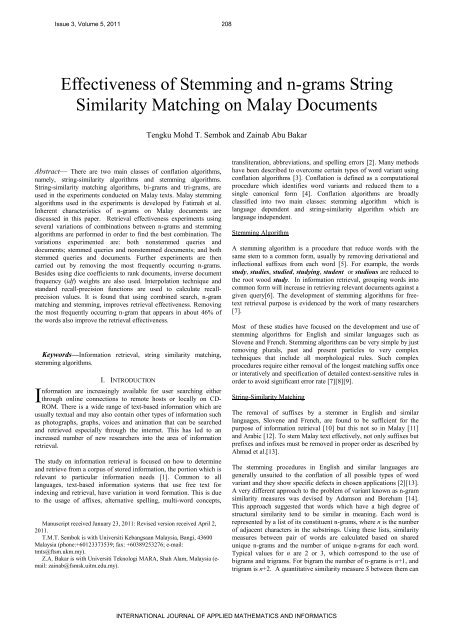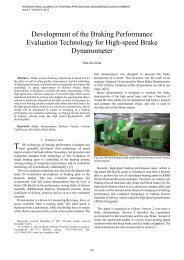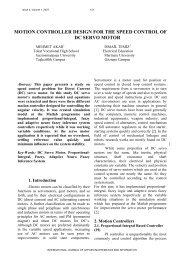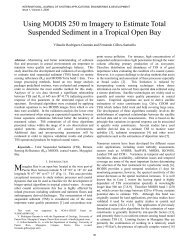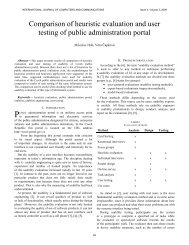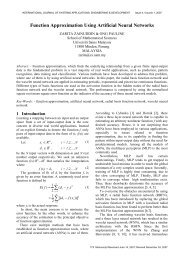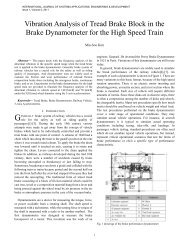Effectiveness of Stemming and n-grams String Similarity Matching ...
Effectiveness of Stemming and n-grams String Similarity Matching ...
Effectiveness of Stemming and n-grams String Similarity Matching ...
You also want an ePaper? Increase the reach of your titles
YUMPU automatically turns print PDFs into web optimized ePapers that Google loves.
Issue 3, Volume 5, 2011 208<strong>Effectiveness</strong> <strong>of</strong> <strong>Stemming</strong> <strong>and</strong> n-<strong>grams</strong> <strong>String</strong><strong>Similarity</strong> <strong>Matching</strong> on Malay DocumentsTengku Mohd T. Sembok <strong>and</strong> Zainab Abu BakarAbstract— There are two main classes <strong>of</strong> conflation algorithms,namely, string-similarity algorithms <strong>and</strong> stemming algorithms.<strong>String</strong>-similarity matching algorithms, bi-<strong>grams</strong> <strong>and</strong> tri-<strong>grams</strong>, areused in the experiments conducted on Malay texts. Malay stemmingalgorithms used in the experiments is developed by Fatimah et al.Inherent characteristics <strong>of</strong> n-<strong>grams</strong> on Malay documents arediscussed in this paper. Retrieval effectiveness experiments usingseveral variations <strong>of</strong> combinations between n-<strong>grams</strong> <strong>and</strong> stemmingalgorithms are performed in order to find the best combination. Thevariations experimented are: both nonstemmed queries <strong>and</strong>documents; stemmed queries <strong>and</strong> nonstemmed documents; <strong>and</strong> bothstemmed queries <strong>and</strong> documents. Further experiments are thencarried out by removing the most frequently occurring n-<strong>grams</strong>.Besides using dice coefficients to rank documents, inverse documentfrequency (idf) weights are also used. Interpolation technique <strong>and</strong>st<strong>and</strong>ard recall-precision functions are used to calculate recallprecisionvalues. It is found that using combined search, n-grammatching <strong>and</strong> stemming, improves retrieval effectiveness. Removingthe most frequently occurring n-gram that appears in about 46% <strong>of</strong>the words also improve the retrieval effectiveness.Keywords—Information retrieval, string similarity matching,stemming algorithms.II. INTRODUCTIONnformation are increasingly available for user searching eitherthrough online connections to remote hosts or locally on CD-ROM. There is a wide range <strong>of</strong> text-based information which areusually textual <strong>and</strong> may also contain other types <strong>of</strong> information suchas photographs, graphs, voices <strong>and</strong> animation that can be searched<strong>and</strong> retrieved especially through the internet. This has led to anincreased number <strong>of</strong> new researchers into the area <strong>of</strong> informationretrieval.The study on information retrieval is focused on how to determine<strong>and</strong> retrieve from a corpus <strong>of</strong> stored information, the portion which isrelevant to particular information needs [1]. Common to alllanguages, text-based information systems that use free text forindexing <strong>and</strong> retrieval, have variation in word formation. This is dueto the usage <strong>of</strong> affixes, alternative spelling, multi-word concepts,Manuscript received January 23, 2011: Revised version received April 2,2011.T.M.T. Sembok is with Universiti Kebangsaan Malaysia, Bangi, 43600Malaysia (phone:+60123373539; fax: +60389253276; e-mail:tmts@ftsm.ukm.my).Z.A. Bakar is with Universiti Teknologi MARA, Shah Alam, Malaysia (email:zainab@fsmsk.uitm.edu.my).transliteration, abbreviations, <strong>and</strong> spelling errors [2]. Many methodshave been described to overcome certain types <strong>of</strong> word variant usingconflation algorithms [3]. Conflation is defined as a computationalprocedure which identifies word variants <strong>and</strong> reduced them to asingle canonical form [4]. Conflation algorithms are broadlyclassified into two main classes: stemming algorithm which islanguage dependent <strong>and</strong> string-similarity algorithm which arelanguage independent.<strong>Stemming</strong> AlgorithmA stemming algorithm is a procedure that reduce words with thesame stem to a common form, usually by removing derivational <strong>and</strong>inflectional suffixes from each word [5]. For example, the wordsstudy, studies, studied, studying, student or studious are reduced tothe root wood study. In information retrieval, grouping words intocommon form will increase in retrieving relevant documents against agiven query[6]. The development <strong>of</strong> stemming algorithms for freetextretrieval purpose is evidenced by the work <strong>of</strong> many researchers[7].Most <strong>of</strong> these studies have focused on the development <strong>and</strong> use <strong>of</strong>stemming algorithms for English <strong>and</strong> similar languages such asSlovene <strong>and</strong> French. <strong>Stemming</strong> algorithms can be very simple by justremoving plurals, past <strong>and</strong> present particles to very complextechniques that include all morphological rules. Such complexprocedures require either removal <strong>of</strong> the longest matching suffix onceor interatively <strong>and</strong> specification <strong>of</strong> detailed context-sensitive rules inorder to avoid significant error rate [7][8][9].<strong>String</strong>-<strong>Similarity</strong> <strong>Matching</strong>The removal <strong>of</strong> suffixes by a stemmer in English <strong>and</strong> similarlanguages, Slovene <strong>and</strong> French, are found to be sufficient for thepurpose <strong>of</strong> information retrieval [10] but this not so in Malay [11]<strong>and</strong> Arabic [12]. To stem Malay text effectively, not only suffixes butprefixes <strong>and</strong> infixes must be removed in proper order as described byAhmad et al.[13].The stemming procedures in English <strong>and</strong> similar languages aregenerally unsuited to the conflation <strong>of</strong> all possible types <strong>of</strong> wordvariant <strong>and</strong> they show specific defects in chosen applications [2][13].A very different approach to the problem <strong>of</strong> variant known as n-<strong>grams</strong>imilarity measures was devised by Adamson <strong>and</strong> Boreham [14].This approach suggested that words which have a high degree <strong>of</strong>structural similarity tend to be similar in meaning. Each word isrepresented by a list <strong>of</strong> its constituent n-<strong>grams</strong>, where n is the number<strong>of</strong> adjacent characters in the substrings. Using these lists, similaritymeasures between pair <strong>of</strong> words are calculated based on sharedunique n-<strong>grams</strong> <strong>and</strong> the number <strong>of</strong> unique n-<strong>grams</strong> for each word.Typical values for n are 2 or 3, which correspond to the use <strong>of</strong>bi<strong>grams</strong> <strong>and</strong> tri<strong>grams</strong>. For bigram the number <strong>of</strong> n-<strong>grams</strong> is n+1, <strong>and</strong>trigram is n+2. A quantitative similarity measure S between them canINTERNATIONAL JOURNAL OF APPLIED MATHEMATICS AND INFORMATICS
Issue 3, Volume 5, 2011 209be computed by using Dice Coefficient or the Overlap Coefficient asshown in Table-1 below.Table-1: <strong>Similarity</strong> Measure <strong>of</strong> Bigram <strong>and</strong> Trigram for wordsconstruct <strong>and</strong> destruct.Unique N-gram <strong>of</strong>Word 1Unique N-gram <strong>of</strong>Word 2A = Unique N-gram<strong>of</strong> Word 1B = Unique N-gram<strong>of</strong> Word 2C = Shared UniqueBigramDice Coefficient=(2C)/(A+B)Overlap Coefficient= C/min(A,B)Note : * denotes a spaceExperiments on N-gram <strong>Matching</strong>Bigram Trigram*c co on ns st tr **c *co con ons nstru uc ct t* str tru ruc uct ct* t***d de es st tr tu **d *de des est struc ct t* tru ruc uct ct* t**10 119 106 60.631579 0.5714290.666667 0.600000Again there are much research on n-gram string-similarity measuresare done on English. Adamson <strong>and</strong> Boreham [14] used intersimilarity coefficient to cluster a small group <strong>of</strong> mathematical titleson the basis <strong>of</strong> their constituent di<strong>grams</strong> <strong>and</strong> form the basis for adocument retrieval system; but the same procedure gave poor resultsusing Cransfield test collection [15]. Using the same collectionLenon et al [4] represented all unique terms occuring in thedocument titles <strong>and</strong> queries by lists <strong>of</strong> constituent di<strong>grams</strong> <strong>and</strong>tri<strong>grams</strong>. Index terms with a similarity coefficient greater than somethreshold were considered to be variants <strong>of</strong> the query term <strong>and</strong> areused for searching relevant documents.Freund <strong>and</strong> Willett [2] performed online query expansion usinginverted file structure constituted <strong>of</strong> di<strong>grams</strong> on Evans <strong>and</strong> Vasmanitest collections. They found that using the digram inverted fileretrieved more non-related terms at lower similarity thresholdcompared to terms retrieved using the trigram inverted file. Theythen used arbitrary truncation <strong>of</strong> the query terms <strong>and</strong> retrieved higherproportion <strong>of</strong> related words <strong>and</strong> still maintain an acceptable level <strong>of</strong>precision.Robertson <strong>and</strong> Willett [16] used n-gram matching, both digram <strong>and</strong>trigram, phonetic <strong>and</strong> non-phonetic coding, <strong>and</strong> dynamicprogramming methods to identify words in the Historical TextDatabasea using query words which are modern English. Theyconcluded that digram string-similarity is the appropriate method tobe implemented in an operational environment where a largedictionary was to be serached.Other sudies on different languages include Turkish <strong>and</strong> Malay.Ekmekcioglu et al.[17] had performed n-gram string-similaritymatching experiments similar to that <strong>of</strong> Lenon et al [4] on sixTurkish databases <strong>and</strong> found that tri<strong>grams</strong> performed slightly betterthan bi<strong>grams</strong> in most <strong>of</strong> the text corpora. They performedexperiments by using stemmed queries <strong>and</strong> nonstemmed dictionary<strong>and</strong> both stemmed queries <strong>and</strong> dictionary. Results show that thestemmed versions performed significantly better than thenonstemmed.Sembok et al. [18] performed experiment using n-gram stringsimilaritymeasure, digram <strong>and</strong> trigram on Malay dictionary <strong>and</strong>queries <strong>and</strong> found that overlap coefficient results are better than dicecoefficients <strong>and</strong> that digram perform significantly better than thetri<strong>grams</strong>. They too found that stemming both queries <strong>and</strong> thedictionary performs significantly better than just stemming only thequeries. However, no conclusion is made between the conventionalstemmed-Boolean approach <strong>and</strong> incorporating-stemming in n-<strong>grams</strong>approach since both approaches are based on different paradigms.Other applications using n-gram include work done byYannakoudakis <strong>and</strong> Angelidakis [19]. They used n-<strong>grams</strong> differentlythat is to show distribution <strong>of</strong> n-<strong>grams</strong> in the Shorter Oxford EnglishDictionary for values <strong>of</strong> n from 2 to 5, from bigram to pentragram.They shown that the corresponding redundancy <strong>of</strong> n-<strong>grams</strong> increasesfrom 0.1067 to 0.3409.Experimental DetailObjectivesThe objectives <strong>of</strong> the experiments are to investigate the inherentcharacteristics <strong>of</strong> n-gram in Malay text <strong>and</strong> to evaluate in terms <strong>of</strong>retrieval effectiveness <strong>of</strong> n-gram matching techniques, bigram <strong>and</strong>trigram, applied to Malay text.Experimental SetupThe Malay test collection used in the experiments is the collection <strong>of</strong>Ahmad et al. [18] which is based on Malay translation <strong>of</strong> the Quran.There are 6236 documents <strong>and</strong> 36 natural language queries.Two types <strong>of</strong> index term dictionary (hereafter abbreviated toITD) are created; index nonstemmed term dictionary (hereafterabbreviated to INTD) <strong>and</strong> index stemmed term dictionary (hereafterabbreviated to ISTD). Stop words are removed before the terms areindexed. From INTD, the number <strong>of</strong> unique index nonstemmed termsis 5525, <strong>and</strong> from ISTD, the number <strong>of</strong> unique index stemmed termsis 2101.Characteristics <strong>of</strong> N-gram on Malay TextThere are 728 distinct bi<strong>grams</strong> <strong>and</strong> 18980 distinct tri<strong>grams</strong> bothinclude leading <strong>and</strong> trailing space(s). The sizes in bytes for each <strong>of</strong>the bigram <strong>and</strong> trigram files are shown in Table 2:Table 2. File sizes <strong>of</strong> Bi<strong>grams</strong> <strong>and</strong> Tri<strong>grams</strong>BigramTrigramINTD 517358 bytes 858580 bytesISTD 145278 bytes 444340 bytesBigram <strong>and</strong> trigram created from INTD herafter are known asnonstemmed- bigram <strong>and</strong> nonstemmed-trigram. And those createdfrom ISTD are known as stemmed-bigram <strong>and</strong> stemmed-trigram.BigramINTERNATIONAL JOURNAL OF APPLIED MATHEMATICS AND INFORMATICS
Issue 3, Volume 5, 2011 210The theoritical maximum number <strong>of</strong> distinct bi<strong>grams</strong> that can befound is 26x26=676 (without spaces) <strong>and</strong> 27x27=729 (with spaces),less 1 bigram <strong>of</strong> the form (space,space) which gives a total <strong>of</strong> 728. Asin English these theoretical maxima can never be reached in practisebecause certain bi<strong>grams</strong> such as QQ <strong>and</strong> XY [19] simply do notoccur in Malay text too. In this Malay text the maximum number <strong>of</strong>non-zero nonstemmed-bi<strong>grams</strong> is 377, only 52%, <strong>and</strong> fromstemmed-bi<strong>grams</strong> 355, only 49%. Table-3 contains the top 100bi<strong>grams</strong> for both nonstemmed <strong>and</strong> stemmed bi<strong>grams</strong>. In order to get ageneral idea about the whole range <strong>of</strong> both bi<strong>grams</strong>, their rankfrequencydistribution <strong>and</strong> zipfian distribution were plotted (Figures1 <strong>and</strong> 2).Tri<strong>grams</strong>The maximum possible number <strong>of</strong> distinct tri<strong>grams</strong> is26x26x26=17576 (without spaces) <strong>and</strong> 27x27x27=19683 (withspaces), less 702 bi<strong>grams</strong> with a space in between, less 1 trigram <strong>of</strong>the form (space,space,space) which gave a total <strong>of</strong> 19890.Appropriate storage arrays were used to hold both nonstemmed <strong>and</strong>stemmed tri<strong>grams</strong> as indicated in Table-2 above. The total maximumnumber <strong>of</strong> non-zero nonstemmed-tri<strong>grams</strong> is 2214 which utilisedonly 12% <strong>and</strong> for stemmed-tri<strong>grams</strong> is 1892 which utilised only 10%.Thus during run time the size <strong>of</strong> array allocation can greatly bereduced.The most 50 frequently occuring tri<strong>grams</strong> are listed in Table-4 above.The rank-frequency distribution <strong>and</strong> zipfian distribution for bothtri<strong>grams</strong> are presented in Figures 3 <strong>and</strong> 4 above.Zipfian DistributionThe curves demonstrating the zipfian distributions in Figures1,2,3<strong>and</strong> 4, <strong>of</strong> the n-gram for Malay text have a similar hyperbolic curvecomplying to the Zipf's law [20] which states that the frequency <strong>of</strong>words <strong>and</strong> the rank order is approximately constant. Such analysisshould not be restricted to just words [1]. Luhn [21] used Zipf's lawto specify upper <strong>and</strong> a lower cut-<strong>of</strong>fs. The words below the upper cut<strong>of</strong>fwere considered to be common <strong>and</strong> those below the lower cut-<strong>of</strong>fto be rare, leaving the rest to be significant words. These cut-<strong>of</strong>fswere established by trial <strong>and</strong> error by estimating in both directionfrom the peak <strong>of</strong> the rank-order position. Thus by removing the mostfrequently n-<strong>grams</strong> should not change the result <strong>of</strong> retrievaleffectiveness <strong>of</strong> the documents, as carried out later.Experimental Evaluation ProcedureThe experiments performed involved the ranking <strong>and</strong> the calculation<strong>of</strong> string similarity measures <strong>of</strong> each unique terms in the ITD to aspecified query term. This procedure is the same as automatic queryexpansion approach as set by Lennon et al [4]. Following are theevaluation procedures that are carried out.Table-3. The Most Frequently Occurring Bi<strong>grams</strong> (with spaces)Nonstemmed StemmedRank Bigra Frequency Bigra Frequency1 m an 2567 m an 4012 ka 1472 a 3413 n 1391 ng 3304 a 1356 s 2425 ng 1136 g 2096 er 1111 b 2087 ya 1104 t 2078 m 1067 h 2049 ny 1062 k 20010 me 917 i 19811 en 909 ah 19512 ah 868 ra 19113 la 826 la 19014 d 731 ka 18815 di 707 n 18416 h 674 at 17517 b 632 ar 17418 k 594 t 17419 pe 581 r 17120 p 578 m 16721 ak 563 ta 16622 be 549 p 16023 em 530 er 15824 at 522 ak 15625 ta 509 ba 15226 ra 498 ma 15027 in 471 k 14428 ar 462 sa 13929 u 461 in 13530 ga 442 u 13031 ba 441 al 12932 i 430 am 12833 ke 428 en 12434 sa 419 un 12135 t 417 as 12036 s 414 pa 11937 nn 395 l 11738 ku 391 da 11539 ha 385 ha 11340 ma 382 a 10941 mu 358 ur 10642 al 349 ga 10343 un 349 s 9944 am 341 ya 9745 pa 335 ri 9546 ik 320 na 9447 se 316 d 9348 tu 310 se 8949 na 308 el 8850 as 299 h 87INTERNATIONAL JOURNAL OF APPLIED MATHEMATICS AND INFORMATICS
Issue 3, Volume 5, 2011 211FrequencyFrquency1600014000120001000080006000400020000BigramFrequency-RankZipfian Distribution0 50 100 150 200 250 300 350 400RankFigure 1. Nonstemmed Bigram Rank-Frequency <strong>and</strong> ZipfianDistribution5000450040003500300025002000150010005000Stemmed BigramFrequency-RankZifpian Distribution0 50 100 150 200 250 300 350 400RankFigure 2. Stemmed Bigram Rank-Frequency <strong>and</strong> ZipfianDistributionTable-4. The Most Frequently Occurring Tri<strong>grams</strong> (with spaces)Nonstemmed StemmedRank Trigram Frequency Trigram Frequency1 n 1391 a 3412 a 1356 s 2423 an 1312 g 2094 kan 1132 b 2085 m 1067 ng 2086 nya 987 t 2077 ya 942 h 2048 me 890 k 2009 d 731 i 19810 h 674 n 18411 b 632 t 17412 di 618 r 17113 k 594 m 16714 p 578 ang 16715 ah 568 p 16016 men 531 k 14417 ang 488 u 13018 u 461 ah 12719 i 430 an 12020 be 429 l 11721 pe 429 at 11622 lah 418 a 10923 t 417 s 9924 s 414 d 9325 ber 402 h 8726 nny 394 se 8627 ann 375 r 8528 ke 367 g 8129 eng 348 m 8030 per 309 ar 7631 aka 286 ba 7332 nga 258 ke 7333 mem 256 ma 7234 g 241 te 7135 ng 240 l 7036 se 223 be 6537 t 218 ak 6538 mu 213 pe 6039 emb 205 ta 6040 ala 202 j 5841 te 201 ka 5742 ngk 196 sa 5743 r 193 ung 5744 gan 192 i 5645 ran 183 ala 5546 era 176 ing 5447 ika 173 am 5248 tan 170 n 5049 ter 167 ha 4950 ara 163 la 49INTERNATIONAL JOURNAL OF APPLIED MATHEMATICS AND INFORMATICS
Issue 3, Volume 5, 2011 213stemming algorithm to the keywords performed better than applyingstemming to the keywords.Finally, Table-5 shows that in general applying stemming algorithmto both keywords <strong>and</strong> documents improve the average recallprecisionvalues. There is an improvement in the retrievaleffectiveness using bigram but the improvement is not significant.Table-5. Best Average Recall-Precision Values <strong>of</strong> VariousExperiments (refer the table Keys for the Experiment column)Experiment ThresholdAveragePrecisionbsksd 1.0 0.183373tsksd 1.0 0.178227brsksd 0.8 0.173899tnknd 0.6 0.147814brnknd 0.6 0.148845tsknd 0.6 0.141466bnknd 1.0 0.143027bsknd 0.7 0.138249NC 0.140768brsknd 0.7 0.136704Keys for Experiment: (example bsksd = bigram;stemmed keywords;stemmed document)Key Description Key Descriptionb bigram k keywordst trigram NC Non-Conflations stemmed r removed the most frequentbigram “an”n nonstemmedd documentFor the detail evaluation <strong>of</strong> the experimental result, see Table-6 inAppendix B.ConclusionsIn this paper inherent characteristics <strong>of</strong> bigram <strong>and</strong> trigram arediscussed. Experiments using various combinations <strong>of</strong> bigram,trigram <strong>and</strong> stemming algorithms are performed on Malay queries<strong>and</strong> documents. Further experiments are then carried out by removingthe most frequently occurring bigram. The experiments show thatusing combined search, n-gram matching <strong>and</strong> stemming, improvesretrieval effectiveness. Removing the most frequently occurring n-gram that appears in about 46% <strong>of</strong> the words also improve theretrieval effectiveness.<strong>Stemming</strong> <strong>and</strong> n<strong>grams</strong> approach have been applied in the Malay-English Terminology Retrieval System by Sembok et al.[24] toretrieve the Malay science terminology. Other experiments onretrieval effectiveness on Malay texts are reported by Hamzah <strong>and</strong>Sembok [25] which experimented on various matching algorithmsuch as cosine, dice, <strong>and</strong> overlap similarity matching. More advanceprocessing on Malay texts retrieval based on semantic approach <strong>and</strong><strong>and</strong> specific domain as performed by Stanojević <strong>and</strong> Vraneš [26] <strong>and</strong>Pohorec et al. [27] shall be our next project. This undertaking shallenable us to proceed further into question answering system forMalay language [28].References[1] van Rijsbergen, C.J. 1979. Information Retrieval. 2nd edition.London: Butterworths.[2] Freund, G.E. <strong>and</strong> Willett, P. 1982. Online Identification <strong>of</strong> wordvariants <strong>and</strong> arbitrary truncation searching using a stringsimilarity measure. Information Technology: Research <strong>and</strong>Development 1: 177-187.[3] Hall, P.A.V. <strong>and</strong> Dowling, G.R. 1980. Approximate stringmatching. Computing Surveys 12: 381-402.[4] Lennon, M. , Peirce, D.S., Tamy, B.D. <strong>and</strong> Willett, P. 1981. Anevaluation <strong>of</strong> some conflation algorithms for informationretrieval. Journal <strong>of</strong> Information Science 3: 177-183.[5] Lovins, J.B. 1968. Development <strong>of</strong> a stemming algorithm.Mechaniacl Translation <strong>and</strong> Computational Linguistics11:22-31.[6] Harman, D. 1991. How effective is suffixing?. Journal <strong>of</strong> theAmerican Society for Information Science 42: 7-15.[7] Popovic, M. <strong>and</strong> Willett, P. 1992. The effectiveness <strong>of</strong> stemmingfor natural language access to Slovene textual data. Journal <strong>of</strong>the American Society for Information Science 43: 384-390.[8] Lennon, M. , Peirce, D.S., Tamy, B.D. <strong>and</strong> Willett, P. 1981. Anevaluation <strong>of</strong> some conflation algorithms for informationretrieval. Journal <strong>of</strong> Information Science 3: 177-183.[9] Savoy, J. 1993. <strong>Stemming</strong> <strong>of</strong> French words based on grammaticalcategories. Journal <strong>of</strong> the American Society for InformationScience 44(1) : 1-9.[10] Porter, M.F. 1980. An algorithm for suffix stripping. Program14(3): 130-137.[11] Sembok, T.M.T., Yus<strong>of</strong>f, M. And Ahmad, F. 1994. A Malaystemming algorithm for information retrieval. Proceedings <strong>of</strong>the 4th International Conference <strong>and</strong> Exhibition on Multi-Lingual Computing. London.[12] Al-Kharashi, I.A. & Evens, M.W. 1994. Comparing words,Stems, <strong>and</strong> Roots as Index Terms in an Arabic InformationRetrieval System. Journal <strong>of</strong> the American Society forInformation Science. 45(8): 548-560.[13] Ahmad, F., Yus<strong>of</strong>f, M, <strong>and</strong> Sembok, T.M.T. 1995. Experimentswith a Malay <strong>Stemming</strong> Algorithm. JASIS.[14] Adamson, G.W. <strong>and</strong> Boreham, J. 1974. The use <strong>of</strong> anassociation measure based on character structure to identifysemantically related pairs <strong>of</strong> words <strong>and</strong> document titles.Information Storage <strong>and</strong> Retrieval 10 : 253-260.[15] Willett, P. 1979. Document retrieval experiments usingvocabularies <strong>of</strong> varying size. II. Hashing, truncation, digram<strong>and</strong> trigram encoding <strong>of</strong> index terms. Journal <strong>of</strong> Documentation35:296-305.[16] Robertson, A.M. (1992). An evaluation <strong>of</strong> algorithmictechniques for the identification <strong>of</strong> word variants in historicaltext database. Ph.D. Thesis. Department <strong>of</strong> Information Studies,University <strong>of</strong> Sheffield.[17] Ekmekcioglu, F.C., Lynch, M.F., <strong>and</strong> Willett, P. 1995.Language processing techniques for the implementation <strong>of</strong> adocument retrieval system for Turkish text databases.Department <strong>of</strong> Information Studies:University <strong>of</strong> Sheffield.[18] Sembok, T.M.T., Palasundram, K., Ali, N.M., Aidanismah, Y.,Wook, T.M.T. 2003. Istilah Sains: A Malay-EnglishTerminology Retrieval System Experiment Using <strong>Stemming</strong> <strong>and</strong>N-grms Approach on Malay Words, Digital Libraries:Technology <strong>and</strong> Management <strong>of</strong> Indigenous Knowledge forGlobal Access, 6 th International Conference on Asian DigitalLibraries, ICADL 2003, Kuala Lumpur. Berlin: Springer.[19] Yannakoudakis, E.J. <strong>and</strong> Angelidakis, G. 1988. An Insight intothe Entropy <strong>and</strong> Redundancy <strong>of</strong> the English Dictionary. IEEEINTERNATIONAL JOURNAL OF APPLIED MATHEMATICS AND INFORMATICS
Issue 3, Volume 5, 2011 214Transactions on Pattern Analysis <strong>and</strong> Machine Intelligence10(6): 960-970.[20] Zipf, H.P. 1949. Human behavior <strong>and</strong> the principle<strong>of</strong> leasteffort. Cambridge, Massachusetts: Addison-Wesley.[21] Luhn, H.P. 1958. The automatic creation <strong>of</strong> literature abstracts.IBM Journal <strong>of</strong> Research <strong>and</strong> Development 2(2): 159-165.[22] Ahmad,F. 1995. A Malay Language Document RetrievalSystem: An Experimental Approach And Analysis. PhD thesis.University Kebangsaan Malaysia.[23] Salton, G. <strong>and</strong> McGill, M.J. 1983. Introduction to ModernInformation Retrieval. New York : McGraw-Hill.[24] Sembok, T.M.T., Palasundram, K., Ali, N.M., Aidanismah, Y.,Wook, T.M.T. 2003. Istilah Sains: A Malay-EnglishTerminology Retrieval System Experiment Using <strong>Stemming</strong> <strong>and</strong>N-grms Approach on Malay Words, Digital Libraries:Technology <strong>and</strong> Management <strong>of</strong> Indigenous Knowledge forGlobal Access, 6 th International Conference on Asian DigitalLibraries, ICADL 2003, Kuala Lumpur. Berlin: Springer.[25] Hamzah, M.P., Sembok, T.M.T. 2004. Evaluating the<strong>Effectiveness</strong> <strong>of</strong> Various <strong>Similarity</strong> Measures on Malay TextualDocuments. Proceedings <strong>of</strong> WSEAS’04, Canary Isl<strong>and</strong>s, Spain,December 17-19, 2004.[26] M. Stanojević, S. Vraneš: Semantic Approach to KnowledgeProcessing, WSEAS Transactions on Information Science <strong>and</strong>Applications, Vol. 5, Issue 6, 2008.[27] S. Pohorec, S., Verlič, M., <strong>and</strong> Zorman, M. 2009. Domainspecific information retrieval system, Proceedings <strong>of</strong> the 13thWSEAS international conference on computers (part <strong>of</strong> the 13thWSEAS CSCC multiconference), July 2009, pp. 502-508.[28] Kadir, R.A., Sembok, T.M.T, <strong>and</strong> Halimah, Z. 2006. BindingSkolem Clauses in Theorem Prover Resolution for AutomatedHypothetical Question Answering. Proceedings <strong>of</strong> the 5thWSEAS International Conference on ComputationalIntelligence Man-Machine Systems <strong>and</strong> Cybernetics(CIMMACS`06).APPENDIX A: SET OF MALAY QUERIES1. Kelahiran Nabi Isa.2. Raja-raja yang beriman.3. Tentang mata.4. Apakah t<strong>and</strong>a-t<strong>and</strong>a hari Kiamat yang dinyatakan di dalamAl-Quran?5. Apakah hadis atau ayat Al-Quran yang membuktikankewujudan alam ini?6. Sebutkan ayat Al-Quran yang menekankan kepada wajibnyaseorang wanita itu menutup aurat.7. Dari ayat/surah manakah boleh didapati berkenaankepentingan ilmu?8. Dari ayat/surah manakah boleh didapati tanggungjawabseorang anak kepada ibu bapanya?9. Dari ayat/surah manakah boleh didapati tanggungjawabseorang abang/kakak terhadap adik-adiknya?10. Saya ingin tahu ciri-ciri berpakaian yang dikehendaki didalam Islam yang patut dipatuhi oleh umatnya.11. Nyatakan ayat-ayat mana dalam Al-Quran yang menyatakantentang kelebihan berpuasa/sembahyang dari segi kesihat<strong>and</strong>an kewajipan.12. Dalam surah apakah yang berkaitan dengan cerita nabinabi?13. Dalam surah manakah yang banyak membicarakan tentanghudud?14. Ingin dapatkan ayat yang mewajibkan sembahyang Jumaat.15. Adakah terdapat pernyataan tentang kewujudan makhluklain di tempat lain/planet lain selain dari di bumi dalam Al-Quran?16. Surah-surah dan pada ayat ke berapa terdapat maklumatberkenaan sesuatu hukum contohnya berkenaan denganhukum mencuri?17. Saya adalah seorang lelaki. Saya ingin dalil Al-Quran yangmenyatakan tentang perempuan-perempuan yang haramsaya kahwini.18. Saya inginkan pilihan ayat-ayat Al-Quran yang menyatakankebesaran Allah melalui kejadian gunung-ganang atau lautuntuk menyelesaikan album 'kebesaran Allah'.19. Perkara-perkara serta hujah yang menunjukkan Al-Quran ituadalah satu mukjizat.20. Capaian maklumat berkenaan rukun Islam iaitu kalimahsyahadah.21. Capaian maklumat berkenaan rukun Islam iaitusembahyang.22. Capaian maklumat berkenaan rukun Islam iaitu puasa.23. Capaian maklumat berkenaan rukun Islam iaitu zakat.24. Capaian maklumat berkenaan rukun Islam iaitu haji.25. Sembahyang-sembahyang sunat.26. Apakah perbezaan antara Islam dan Kristian dan Yahudiyang disebut dalam Al-Quran?27. Adakah dinyatakan secara jelas perkaitan antara para Nabidari segi persamaan, keturunan atau ciri-ciri seorang nabiatau rasul?28. Maklumat-maklumat/ayat mengenai hari kiamat.29. Ayat-ayat Al-Quran yang menceritakan tentang sejarahpeperangan yang telah berlaku.30. Ayat-ayat Al-Quran yang menerangkan bab perkahwinan.31. Dalam surah manakah menceritakan kisah beberapa oranglelaki tertidur di dalam gua selama beratus-ratus tahun?32. Senaraikan nama surah-surah yang menceritakan ataumenggambarkan keadaan jannah dan neraka.33. Maklumat berkenaan dengan menyucikan diri (bersuci).34. Maklumat tentang tuntutan berperang pada jalan Allah.35. Maklumat tentang tuntutan berdakwah.36. Apa jua kejadian malapetaka di bumi Allah ini merupakan satupetunjuk daripada Allah. Bagaimana Al-Quran dapatmembuktikannya (melalui isi k<strong>and</strong>ungannya)?(Note : For the relevant judgement please refer to Ahmad [22])INTERNATIONAL JOURNAL OF APPLIED MATHEMATICS AND INFORMATICS
Issue 3, Volume 5, 2011 215APPENDIX BTable-6. Best Average Recall-Precision Values <strong>of</strong> Various Experiments (refer to Keys for the meaning <strong>of</strong> abbreviations)Recall ValuesExp Thr 0.1 0.2 0.3 0.4 0.5 0.6 0.7 0.8 0.9 1.0 Averagebsksd 1.0 0.391484 0.328080 0.263509 0.231146 0.156648 0.140584 0.130282 0.072540 0.066624 0.052831 0.183373tsksd 1.0 0.389386 0.320780 0.259413 0.218424 0.146872 0.135887 0.126141 0.068861 0.063680 0.052829 0.178227brsksd 0.8 0.378653 0.309316 0.250050 0.209260 0.146191 0.134998 0.125308 0.068771 0.063618 0.052824 0.173899tnknd 0.6 0.360302 0.270907 0.230304 0.206354 0.137955 0.095774 0.076317 0.039792 0.031956 0.028474 0.147814brnknd 0.6 0.352555 0.249903 0.209216 0.189971 0.123364 0.112822 0.104299 0.057402 0.048723 0.040193 0.148845tsknd 0.6 0.348821 0.247188 0.221274 0.199600 0.130944 0.096458 0.076618 0.039492 0.028743 0.025527 0.141466bnknd 1.0 0.343802 0.277457 0.243808 0.208001 0.128378 0.091160 0.049507 0.034135 0.028543 0.025479 0.143027bsknd 0.7 0.340093 0.244674 0.220026 0.192138 0.128481 0.093494 0.072450 0.037318 0.028448 0.025363 0.138249NC 0.337437 0.275656 0.238384 0.203974 0.126217 0.088235 0.046583 0.035510 0.029375 0.026312 0.140768brsknd 0.7 0.326174 0.238434 0.218717 0.193873 0.128521 0.094869 0.074654 0.037600 0.028635 0.025563 0.136704KeysExpbtsndThrskNCExperiment/Methodbigramtri<strong>grams</strong>temmednonstemmeddocumentThreshold ValueskeywordsNon-ConflationINTERNATIONAL JOURNAL OF APPLIED MATHEMATICS AND INFORMATICS


